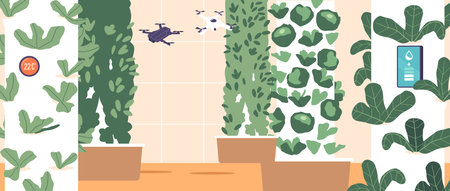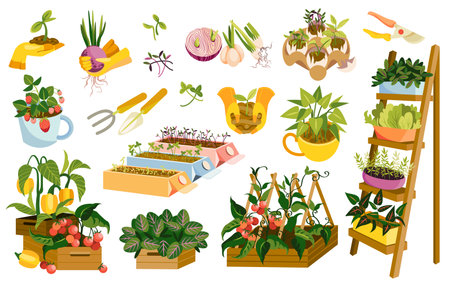Introduction to Seasonal Container Gardening for Curb Appeal
When it comes to making a positive first impression, your home’s exterior speaks volumes. One of the simplest and most sustainable ways to enhance curb appeal is through seasonal container gardening. This eco-friendly practice not only boosts your homes visual charm but also reflects a commitment to environmentally responsible landscaping. By choosing native plants, rotating displays with the seasons, and using repurposed or recyclable containers, you can create vibrant entryways that welcome visitors and neighbors alike. Seasonal container gardens offer flexibility in design and make it easy to refresh your outdoor space throughout the year, all while supporting pollinators and reducing your environmental footprint. Discover how these living arrangements can transform your front porch or walkway into a stunning, sustainable showcase that truly stands out in any neighborhood.
2. Choosing Eco-conscious Containers and Materials
When it comes to maximizing curb appeal with seasonal container gardening, selecting eco-friendly containers and sustainable soil options is key. American homeowners are increasingly embracing green living, making it easy to find container materials that not only look great but also support environmental responsibility. Opt for planters made from recycled plastics, reclaimed wood, biodegradable fibers, or upcycled metals—many of which are readily available at local garden centers or through community recycling initiatives. Below is a quick comparison of popular sustainable container choices:
| Container Material | Sustainability Features | American Sourcing/Trends |
|---|---|---|
| Recycled Plastic | Diverts waste from landfills; durable and weather-resistant | Widely available through national retailers; supports domestic recycling efforts |
| Reclaimed Wood | Reduces deforestation; naturally biodegradable when untreated | Popular in DIY projects; often sourced from local lumber yards or salvage shops |
| Bamboo/Fiber Pots | Renewable resource; compostable after use | Gaining popularity in eco-conscious communities; perfect for seasonal displays |
| Upcycled Metal | Repurposes existing materials; long-lasting and stylishly rustic | Commonly found at flea markets and vintage stores across the U.S. |
Sustainable Soil Choices for Healthier Gardens
The foundation of any thriving container garden is healthy soil. In the spirit of sustainability, consider using organic potting mixes blended with locally sourced compost. These options reduce transportation emissions and support regional circular economies. Many American municipalities offer composting programs that provide residents with nutrient-rich soil amendments, closing the loop on green waste and enhancing your plants’ vitality.
Tips for Responsible Disposal and Recycling
Before disposing of old containers or soil, check your city’s recycling guidelines. Some areas accept plastic pots in curbside bins, while others have designated drop-off locations for garden waste. By aligning your choices with local recycling efforts, you help strengthen community-wide environmental stewardship and set an example for neighbors aiming to boost their own curb appeal sustainably.

3. Selecting Native and Pollinator-friendly Plants by Season
Choosing the right plants for your container garden is not just about aesthetics—its also about supporting local ecosystems and maximizing your curb appeal throughout the year. By focusing on native and pollinator-friendly species, you can ensure your entryway is both beautiful and environmentally conscious, no matter the season.
Spring: Welcoming Renewal with Early Blooms
As winter fades, spring offers an opportunity to refresh your curbside containers with vibrant color. Opt for locally-sourced native flowers like Echinacea (coneflower), Penstemon, or wild columbine. These early bloomers not only attract bees and butterflies emerging from dormancy but are also adapted to regional climate conditions, reducing your need for extra water or fertilizers.
Summer: Bursting Color and Sustained Support
During the hot months, choose heat-tolerant natives such as black-eyed Susan (Rudbeckia hirta), milkweed (Asclepias spp.), and blanket flower (Gaillardia). These plants are a magnet for monarchs, swallowtails, and hummingbirds, filling your entryway with life while thriving in high temperatures. Their deep roots help conserve water, making them a smart choice for sustainable curb appeal.
Fall: Late-season Interest and Food Sources
As days grow shorter, select plants that offer late-season blooms and seed heads for wildlife. Asters and goldenrod are fall favorites that provide essential nectar for migrating pollinators. Their rich hues bring warmth to your doorstep as summer’s brightness fades, ensuring your containers remain eye-catching well into autumn.
Winter: Evergreens and Native Grasses for Texture
Even in the chill of winter, you can maintain inviting curb appeal by incorporating native evergreens like inkberry holly (Ilex glabra) or dwarf spruce. Pair these with ornamental native grasses such as little bluestem for texture and movement. While blooms may be scarce, these selections provide shelter for overwintering insects and add visual interest until spring returns.
Sourcing Responsibly for Local Impact
Whenever possible, source your plants from local nurseries specializing in native varieties. This reduces transportation emissions and ensures that your choices are well-suited to regional conditions. By aligning plant selection with both seasonal beauty and ecological benefit, you create a welcoming entryway that’s a win-win for your home and the planet.
Water-wise Maintenance and Responsible Fertilizing
Maintaining eye-catching curb appeal through seasonal container gardening doesn’t have to come at the expense of environmental responsibility. In fact, a water-wise approach paired with responsible fertilizing can help you conserve resources while keeping your planters vibrant year-round. Here’s how you can strike the right balance:
Efficient Watering Strategies
Smart watering not only saves water but also encourages healthier root systems in your container gardens. Water early in the morning or late in the evening to minimize evaporation. Always check soil moisture before watering—stick your finger about an inch deep; if it’s dry, it’s time to water. Self-watering containers and drip irrigation systems are smart investments for busy homeowners looking to reduce water waste.
Quick Tips for Water Conservation
| Tip | Benefit |
|---|---|
| Use mulch on top of soil | Reduces evaporation & keeps roots cool |
| Group containers by water needs | Prevents overwatering and simplifies care |
| Collect rainwater for irrigation | Cuts down on municipal water use |
| Choose drought-tolerant plants | Lowers overall water requirements |
Organic and Responsible Fertilizing Practices
Avoid synthetic fertilizers that can leach into groundwater or harm pollinators. Instead, opt for slow-release organic fertilizers such as compost tea, worm castings, or fish emulsion. These natural options feed your plants gradually while supporting beneficial soil microbes. Apply fertilizers sparingly—over-fertilizing can do more harm than good, leading to nutrient runoff and weak plant growth.
Sustainable Feeding Schedule Example
| Season | Fertilizer Type | Frequency |
|---|---|---|
| Spring | Compost tea or worm castings | Every 4-6 weeks |
| Summer | Fish emulsion (diluted) | Every 3-4 weeks |
| Fall/Winter | No fertilizer (rest period) | N/A unless overwintering annuals indoors |
By integrating these eco-friendly maintenance habits, you’ll not only keep your planters lush but also champion sustainability within your neighborhood. Thoughtful stewardship of resources ensures your curb appeal contributes positively to the local ecosystem, setting an example for others in your community.
5. Easy Seasonal Swaps for Year-round Curb Appeal
Keeping your home’s entrance vibrant and attractive doesn’t have to be complicated or expensive. By embracing easy seasonal swaps in your container gardens, you can ensure a welcoming atmosphere that reflects the beauty of every season. Refreshing your containers is as simple as updating plant choices and decorative accents as the weather shifts, so your curb appeal never goes out of style.
Spring: Fresh Beginnings
As winter fades, swap out cold-tolerant evergreens and dried stems for cheerful spring blooms like pansies, tulips, and daffodils. Mixing in native wildflowers not only boosts color but also supports pollinators emerging from hibernation—an eco-friendly way to welcome the new season.
Summer: Lush and Vibrant
When the temperatures rise, opt for heat-loving plants such as petunias, marigolds, and ornamental grasses. Consider incorporating edible herbs or drought-resistant succulents for both sustainability and low maintenance. Adding a layer of mulch helps conserve water and keeps containers looking tidy through the hottest months.
Fall: Warm Tones and Texture
Autumn is the perfect time to transition to rich colors with mums, asters, and ornamental kale. Accent with mini pumpkins or gourds for an authentic American fall vibe. Swap out summer flowers gradually to keep containers looking full while embracing seasonal change.
Winter: Evergreens and Festive Touches
Don’t let winter dull your entryway! Use hardy evergreens, red twig dogwood branches, or berry-laden holly for structure and color. Add reusable decorations like pinecones or LED string lights to keep things festive while minimizing waste—a nod to both style and sustainability.
Sustainable Practices All Year Long
Whenever you make seasonal swaps, compost spent plants and reuse soil when possible. Opt for organic fertilizers to keep your containers thriving without harming local ecosystems. By planning simple changes each season, you’ll maintain year-round curb appeal while practicing mindful stewardship of your outdoor space.
6. Incorporating Recycled and Upcycled Decor
One of the most impactful ways to elevate your curb appeal while honoring eco-friendly values is by integrating recycled and upcycled decor into your seasonal container gardening. By finding creative uses for repurposed items—think old wooden crates, vintage watering cans, or even sturdy rain boots—you not only save resources from landfills but also bring authentic character right to your doorstep. Choose planters made from reclaimed materials or DIY your own using household items that have outlived their original purpose. Add accents like solar-powered garden lights, wind chimes crafted from salvaged metal, or decorative stones sourced from previous landscaping projects. These sustainable choices tell a story and spark conversations with neighbors and guests alike. By embracing upcycled decor, you transform your front porch or entryway into a unique, personalized statement piece that reflects your commitment to sustainability and American ingenuity. Every reused accent contributes to a greener planet and a more welcoming home.


